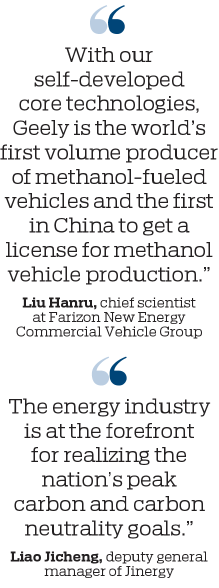Shanxi in fast lane of low-carbon development
Updated: 2024-08-09
Media group on tour discovers province is pulling out all the stops to meet the nation's ambitious green targets
In a recent media tour to witness the progress of low-carbon development in China's energy-rich regions – including Shanxi, Shaanxi, Henan and Shandong provinces, as well as the Inner Mongolia autonomous region, reporters found Shanxi a worthy example.
The North China province, which used to rely on coal mining and other heavy industries, began an industrial transformation program in 2019, aiming to upgrade its traditional coal mining and cultivate emerging industries for economic diversification and low-carbon development.
The media group, which included journalists from across the country, toured the Shanxi city of Jinzhong on July 22.
To contribute to Shanxi's low-carbon growth, Jinzhong has developed a complete methanol industry chain. Methanol is a clean, renewable energy resource featuring high combustion efficiency and low emissions. It can be produced from coal, coking gas, natural gas and biomass.
Jinzhong, as well as the rest of Shanxi, is rich in coal and coking gas which can be used to make methanol. The city began to develop the methanol industry some 40 years ago.
It was Farizon New Energy Commercial Vehicle Group, the Jinzhong arm of renowned domestic automaker Geely Auto, that pushed the industry into the fast lane of development.
At the production plant of methanol-fueled vehicles, an executive told reporters that Geely began research and development of methanol-fueled vehicles about two decades ago. It is now one of the leaders in the sector worldwide.
Geely's Jinzhong facility began the world's first mass production of methanol-powered heavy-duty trucks and methanol-electric hybrid passenger cars in June 2022.
Liu Hanru, chief scientist at Farizon New Energy Commercial Vehicle Group, said the mass-produced truck is its second generation of heavy trucks powered by methanol.
"Compared with its previous version, which was a model for trial operation, the new truck features stronger performance and lower energy consumption. Thus, it can help owners substantially cut operational costs," said Liu.
The executive added that the hybrid car belongs to the fourth generation of the company's methanol passenger vehicles.
Liu said the maturity in vehicle-making technologies and the availability of methanol are two decisive factors in the sector.
He said Geely began to develop technologies for methanol vehicles in 2005 and has since made breakthroughs in the production of engines and components.
"With our self-developed core technologies, Geely is the world's first volume producer of methanol-fueled vehicles and the first in China to get a license for methanol vehicle production," Liu said.
Geely established Shanxi New Energy Automobiles Corp – the predecessor of Farizon New Energy Commercial Vehicle Group – in the city of Jinzhong in 2011. Its facility began producing methanol and pure electric vehicles in 2017.
When talking about the availability of methanol, Liu said Jinzhong, as well as Shanxi, has unique advantages in developing such fuel.
He explained that carbon dioxide, as a raw material for methanol production, can be captured from the emissions of Shanxi's coal-fired power plants, coking plants and other industrial facilities that consume coal.
Jinzhong is one of the cities piloting the development of methanol fuel and methanol vehicle production. It now boasts a complete methanol industry chain, ranging from R&D, equipment manufacturing, methanol production and transportation to filling stations.
Local officials said that Jinzhong initiated a plan in 2022 to establish itself as a national-level demonstration zone for the methanol economy.
Over a three-year period, the city aims to produce 1 million metric tons of methanol, 100,000 methanol-powered passenger vehicles and 50,000 methanol-fueled heavy-duty trucks annually. In addition, about 100 methanol filling stations will be added each year in the city. In total, the methanol industry chain is expected to generate more than 100 billion yuan ($14.01 billion) in annual revenue, according to the officials.
While Geely's Jinzhong facility is delving into the methanol energy industry, Jinneng Clean Energy Technology, or Jinergy, demonstrated to the media group another aspect of new energy technology development: the R&D and production of the advanced TOPCon photovoltaic cells.
At the production base of Jinergy – a world-leading PV manufacturer and clean energy provider incorporated under Jinneng Holding Group in Jinzhong city – more than 100 5G-connected smart carts were busy transporting silicon wafers to the automated production lines with an annual output of 4 gigawatts of high-efficiency photovoltaic cells.
Jinergy recently announced that its TOPCon high-efficiency heterojunction solar cells were produced with a photoelectric conversion efficiency of more than 25.5 percent, one of the highest rates for the industry worldwide.
Jinergy began R&D on heterojunction cells in 2016 and realized mass production of the products in 2017. It started to develop the more advanced TOPCon cell technology in 2019.
As the first domestic mass production facility of heterojunction cells, Jinergy has now sold products to more than 50 countries and regions across the world.
"The energy industry is at the forefront for realizing the nation's peak carbon and carbon neutrality goals," said Liao Jicheng, deputy general manager of Jinergy. "We will continue to develop more products with higher quality and efficiency to support China's low-carbon development."
For an energy company, efficiency always means better economic and environmental benefits, the media group learned at a power plant in Jinzhong.
Inside Ruiguang Thermal Power, journalists were led to the central control room, where large displays showed figures relating to the output and efficiency of its two power generation sets.
The two generation sets, each with a capacity of 300,000 kilowatts, can generate 3.3 billion kilowatt-hours of power annually, supplying electricity to the whole province.
The company is creating benefits other than power generation through its recycling practices, according to Dong Xin, deputy general manager of Ruiguang.
"We have realized 100 percent utilization of solid waste," Dong said. "The coal ash and cinder are used to produce construction materials like cement and gypsum."
Heat residue from coal-fired power generation is also collected and supplied to cities like Jinzhong and Taiyuan, according to Dong.
"Despite the growing use of new energy resources, coal-fired power generation still occupies a dominant position in today's electricity industry," Dong said. "Upgrading the facilities with intelligent technologies and improving efficiency through recycling are a practical and cost-effective method of carbon reduction."
One of the solutions to improve efficiency is the use of smart boilers, Dong said. He explained that the use of digital technologies can adjust the volume of coal combustion according to practical requirements, thus economizing the use of fuel and reducing emissions.
Feng Siquan contributed to this story.
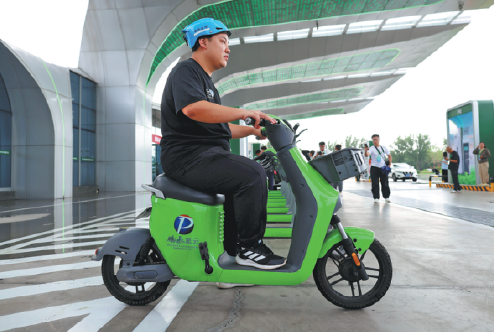
A man rides a hydrogen-powered scooter in Shanxi's Xiaoyi city. ZHU XINGXIN/Provided to CHINA DAILY
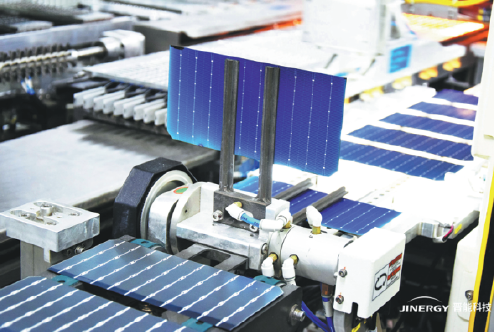
Photovoltaic cells are produced on the automated production line at Jinergy. Provided to CHINA DAILY
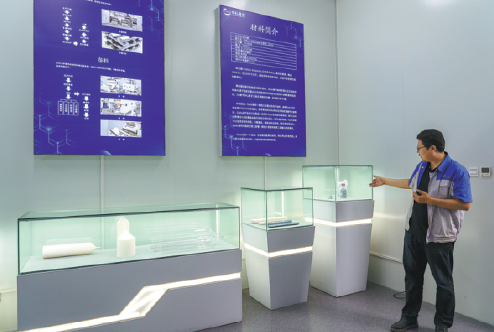
An executive of Xinzhou-based China Crystal Technologies introduces products to journalists at a showroom. Provided to CHINA DAILY
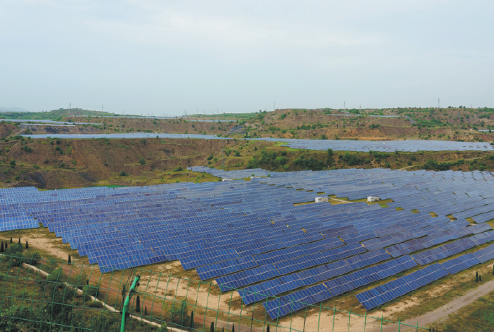
A solar farm built on the a depleted coal mine of Jinyang New Energy Power in Yangquan's Yuxian county. Provided to CHINA DAILY
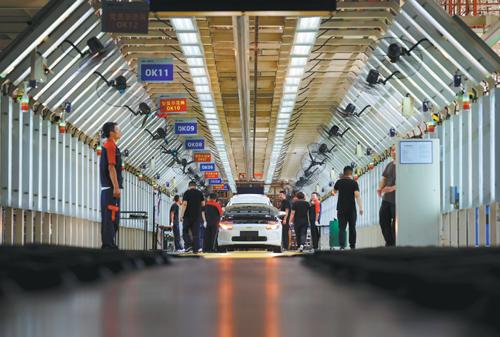
Workers at Geely's Jinzhong plant inspect a methanol-electric hybrid car as it rolls through the final stages of the assembly line. ZHU XINGXIN/Provided to CHINA DAILY

From left: A new energy car is assembled at Geely's Jinzhong facility. A technician tests the product quality of photovoltaic cells at Jinergy's production plant in Jinzhong city. Provided to CHINA DAILY
